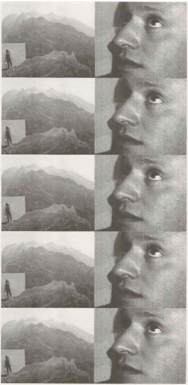The gap between a mummified avant-garde and still very much abve painting turns this film into an almost frightening experience. Do Straub and Huillet empathise with Cézanne at all, do they in any way love the work of this malicious master, or is their only motive to drag Cézanne down into their horrifyingly rhetorical story?
We listen to fragments of a conversation that Joachim Gasquet had with Cézanne;
Cézannes voice has become the alienating voice of Huillet, illustrated by photos of the painter at work, some paintings and images of, presumably, his house in Aix-en-Provence. There is a revolving camera movement over a new town area with motorways; Cézannes landscape engrossed in the insanity of our modern living environment. There is a fragment from Jean Renoirs Madame Bovary, and a quote from Tod des Empedocles by Straub and Huillet. In hallucinating phrases, Hölderlin evokes the dawn of a Greek civilisation; here, the sun is still new, every day.
Cézanne is not really the painter of the refined sensory perception. He is neither a Turner nor a Monet, who, as if from a sensuousness of his own, magically adorns the world in illusive hazes and clouds of flowers. Turner and Monet knew that all it takes is a cross-eyed glance, an inaccurate focus, to reduce our environment to poetic material. Cézanne needed abstract conceptions and mathematical forms to embody the environment. His work is never the poetry of the smile. Dour and contrary in spite of himself, I am inclined to think - his work reaches an area that he himself seems unable to fathom. He pontificates to Gasquet, but I never hear him talk about what he means to me, specifically. Cézanne as the painter who travels towards the borders of the invisible, the ineffable, and from there, in a vacuum of meanings, transmits his messages. Cézanne is the medium used by the art of painting, contrary, perhaps, to his own opinion.
My Cézanne usually consists of only two paintings in Amsterdam's Stedelijk Museum. There, once or twice a year, I test my latest findings. How many Cézannes have I seen face-to-face, how long ago, and in what respect does my mental picture of the works differ from the actual paintings? I project nearly every new view I develop on painting onto Cézanne. That is, onto the image that I hold of him, an image that is daily affected, enriched, changed, by innumerable other experiences. How much Renoir is there in my Cézanne? Did I not mistake a Monet for a Cézanne, the other day?
Vis-a-vis the personal and slowly to be unravelled secret of Cézannes painting, Staub and Huillet put the rhetoric of image and language. Depersonalised photographs of the painter, reduced to stagnant representations. And - most shocking paradox - on film, 24 images per second, Cézanne s paintings immobilised. Confronted with a painting of the master, our ever moving eye scans over the brush strokes, the touches of paint scanning our eyes in return, while Cézannes brings an ever vibrating message from a distant past. A time machine which, for the time being, still keeps the upper hand over all mechanical reproduction techniques, and certainly over that long since ended interim-regime of the film. Have Straub and Huillet lost their belief in film? With this foolish idea to convey Cézannes message on film tape, are they trying to expose the definite bankruptcy of film as a medium?
translation Olivier/Wylie
